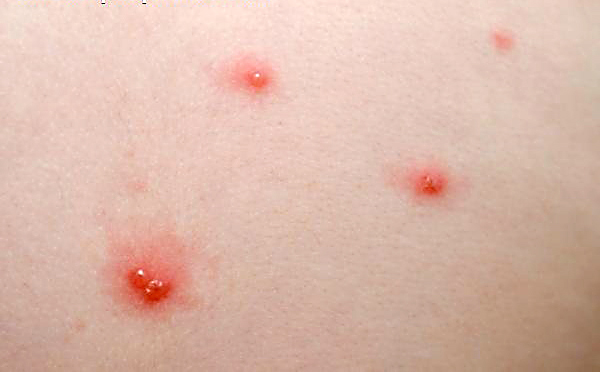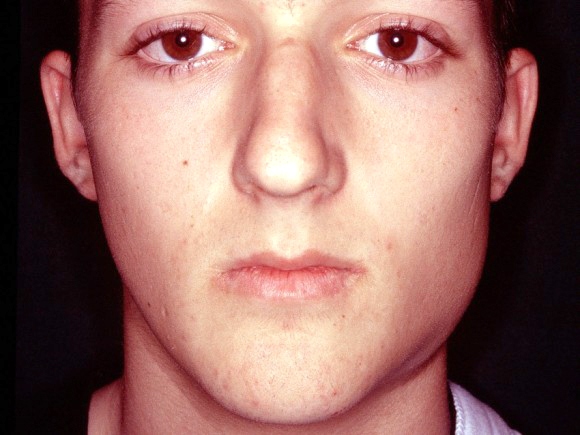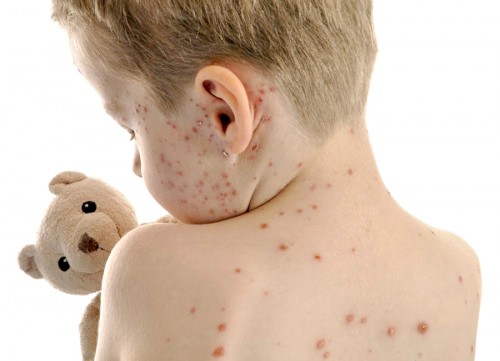Child Diseases Parents Should Know – Part 5
As they say at the theater: “Today’s featured diseases really need no introduction. Bothering us for millennia but only recently introduced to the vaccine circuit… a frequent winter-spring visitor playing to packed crowds of especially 10-year-olds… contracted by children everywhere… the bane to young and old alike… the old… the unforgettable — Heeeeerrrrrr’s… Chickenpox!”
The “rash” of Varicella-Zoster, ChickenpoxIn this series we’re building a list of the commonly common child diseases parents should know about – if for no other reason than to help you appear smart in conversations or at parties.
We first talked about Croup and Bronchiolitis. Second we explained the ubiquitous ear infections and “glue” ear. Part 3 discussed Hand, Foot and Mouth Disease, Conjunctivitis and Fifth Disease then Part 4 covered Rotavirus and Kawasaki Disease.
Yet More Diseases For Parents To Know
Chickenpox, Measles, Mumps and Rubella
Today, we’re going to mention several diseases that have been around since the time when the Dead Sea was only sick. They were the maladies for which “doctors” were even invented in the first place. In fact, they were there when you could count the known diseases on your fingers – and they did, by giving them numbers.
Chickenpox (Varicella)
Chickenpox is NOT one of the “numbered” diseases of childhood, even though it has been around at least as long as any that are; because, as we’ve already discussed, they only numbered diseases causing “rashes” back then and this is NOT a rash – it’s a POX.
Before the vaccine became available (US 1965) nearly everyone contracted the disease before they were 10 or so; because, the virus is both airborne and spread by direct contact and is contracted from someone even 3-4 days BEFORE they even become ill. By the time you know you’re sick you’ve already spread it around to all your friends and family!
 Chickenpox (Varicella) rash – day 1Prior to immunization Chickenpox attacked 4 million people every year in the US – hospitalized 10,600 of them and killed about 150. It’s still around and waiting for those who either can’t get or decide to reject the vaccination.
Chickenpox (Varicella) rash – day 1Prior to immunization Chickenpox attacked 4 million people every year in the US – hospitalized 10,600 of them and killed about 150. It’s still around and waiting for those who either can’t get or decide to reject the vaccination.
It starts with headache, fatigue, loss of appetite, muscle aches and fever then progresses into a rash that first looks like a tiny “dew drop on a rose petal” – blister on a red base. Each blister enlarges, pops and crusts in succession and there are several “crops” of them; so, at any one time there are vesicles in all stages of healing at once.
You are contagious from 3-4 days BEFORE you are ill until the last vesicle has crusted over (5-6 days) and pretty much itch all through the rash. A secondary bacterial infection of one of the vesicles is common so children are frequently placed in light cotton gloves throughout. Oatmeal baths, calamine lotion and antihistamines are all used to help the itch.
Immunization against Varicella is part of the US preventive program (not the British) and requires two injections spaced months apart. The Varicella Zoster Virus (HZV) is one of those that “keep on giving” because in some people it doesn’t really exit the body but lies dormant in the nervous system to flair up in later years as Shingles.
Hygiene is critical to thwart the spread. Luckily, it’s “killed” by bleach, detergents and desiccation (drying).
Needless to say, Varicella is dangerous to newborn babies, adults, pregnant women, the elderly and the immunocompromised due to various serious complications. Once you’ve had chickenpox it is rare to catch it a second time.
Measles
Measles, or “first disease,” is another one of the “Kid Killer” diseases which has only been “beaten back” by large efforts at vaccinating millions of children. And, a previous article has expounded upon it extensively.
When you walk through any of the historic cemeteries and see that they are always more than half full of children – you need wonder about “why” only long enough to realize what kind of devastation the diseases on THIS PAGE have had on families of the world.
If you have kept your children’s immunizations up to date you shouldn’t need to worry about this disease bothering your family. Measles starts with a fever, runny nose and cough. Then, as these symptoms fade, the rash appears over the full-body. Most children are better within a couple of weeks, but more than a few do go on to develop substantial pneumonia and other problems.
Mumps
 Teenage boy with MumpsIncluded as a vaccination in the standard MMR, Mumps is a virus which is transmitted through infected saliva from the glands it infects – usually the parotid gland.
Teenage boy with MumpsIncluded as a vaccination in the standard MMR, Mumps is a virus which is transmitted through infected saliva from the glands it infects – usually the parotid gland.
Perhaps as much as a fifth of infections go unrecognized by the person; so, many others can be further infected without knowing the person is doing it. Most, however, develop headache, fever, malaise and loss of appetite then go on to have painful swelling of their glands in front of the ear but between it and the jaw.
In children the disease is usually self-limiting and not severe; but, within and past puberty, the mumps virus can cause orchitis (infected testicles) about 15% of the time and result in sterility – that’s in addition to causing things like pancreatitis, meningitis, encephalitis, Oophoritis (ovaries), hearing loss and spontaneous abortion.
Treatment is only with pain relievers such as acetaminophen and avoiding foods that make the gland want to work harder, such as anything tart or sour (or, even watching others eat them.)
From becoming infected to showing symptoms can be up to two weeks or so. The misery usually is gone by another two weeks, unless there are complications. And, you MUST call ahead if you intend to go into a doctor’s office or other clinic in order that you might be isolated and prevent community spread to the unimmunized or very ill.
Rubella (German measles)
Also a disease that your MMR shot will protect you from, Rubella , “third disease, “has its own full article within prior pages when we wrote about the numbered diseases of childhood.
Although the actual German Measles (or “soft” measles as it is also known by) usually is more mild and less troublesome, it, none-the-less, is still a killer. It kills and maims unborn babies.
The massive undertaking to control this disease has not only been through immunization of children; but, by careful surveillance of nearly every pregnancy cared for by a physician.
– – 0 – –
We’re well on our way to completing the “commonly common” childhood diseases that all parents should know about; but, there’s a bit more yet… next time Meningitis, among others.
11 Posts in Childhood Diseases (childdiseases) Series
- Part 10 - Lyme - Allergies – 9 Oct 2014
- Part 9 - Impetigo - Influenza – 1 Oct 2014
- Part 8 - Polio - MRSA – 23 Sep 2014
- Part 7 - Meningitis - Scarlet Fever – 11 Sep 2014
- Part 6 - Diptheria - Tetanus – 3 Sep 2014
- Part 5 - Varicella - Rubella – 18 Aug 2014
- Part 4 - Rotavirus - Kawasaki's – 10 Aug 2014
- Part 3 - Hand, Foot, Mouth and Fifth disease – 29 Jul 2014
- Part 2 - Otitis, Glue ear – 21 Jul 2014
- Part 1 - Croup, Bronchiolitis – 17 Jul 2014
- Childhood Diseases Parents Should Know: Intro/Index – 15 Jul 2014
Advertisement by Google
(sorry, only few pages have ads)

